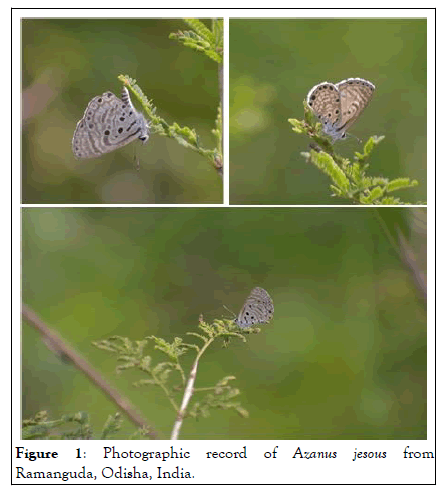Entomology, Ornithology & Herpetology: Current Research
Open Access
ISSN: 2161-0983
ISSN: 2161-0983
Short Communication - (2023)Volume 12, Issue 1
Butterflies are the most beautiful and colorful creatures on the earth and have a great aesthetic value. Butterflies are important bio indicators which should be protected to conserve the biodiversity and environment. Different species of plants and habitats in Odisha city attracts wide variety of butterfly fauna, which play a vital role in pollination of various flowering plants besides a key component of food chain. Various ecosystems of our country support different species of butterfly. In this paper we have documented the presence of an uncommon butterfly species Azanus jesous for the first time from Odisha, India. This study can be helpful for establishing a baseline record of this butterfly species distribution studies in this area.
Butterfly; Rare documentation; Bioindicators; Lepidoptera; Distribution
Butterflies are generally regarded as one of the best taxonomically studied group of insects. Butterflies enable sustenance of ecosystem services through their role in pollination and serving as important food chain components. Being potential pollinating agents of their nectar plants as well as indicators of the health and quality of their host plants and the ecosystem, exploration of butterfly fauna thus becomes important in identifying and preserving potential habitats under threat [1-3].
There has also been an alarming rise in industrial and automobile pollution in Indian metropolitan cities. With the shrinking of greenery and increase in pollution, butterflies, birds and all our wildlife are fast disappearing. The net result is a complete imbalance of the ecosystem and extinction of many species. Despite the fast growth, Indian cities still have diverse serene habitats such as the traffic Island gardens in the middle of busy roads, parks or urban forest areas with mixed deciduous and non deciduous trees and scrubland serving as ideal habitats for various types of insects, especially butterflies.
Institutional campuses with undisturbed natural vegetation and seasonal flowering plantation provide potential habitat for butterfly population as they are devoid of any developmental activities and pollution. Insects are extremely important components of the bio indicators of the world. Butterflies are one of the most amazing and magnificent elements of biodiversity. They are most beautiful and attractive than most other insects and have fascinated human imagination and creativity. The charismatic color pattern and the bouncy flight from flower to flower make then a well-known guest in our gardens. Forests continue to show massive loss in many tropical countries around the world. Deforestation is as high as or, in some countries, even higher than in previous decades [4,5].
From an entomological perspective, Odisha is one of the least explored regions. Among insects, butterflies are certainly most popular and eminent group. Butterflies occupy a vital position in ecosystems and their occurrence and diversity are considered as good indicators of the health of any given terrestrial biotope. Butterflies and moths (order Lepidoptera) offer good opportunities for studies on population and community ecology. India hosts about 1,504 species of butterflies.
Some habitats components that influence the patterns of the butterfly diversity are determined by abiotic and biotic factors such as vegetation including host plants, food availability, temperature, and wind exposure.
The butterfly Azanus jesous is a small lycaenid or blue butterfly found in Africa, Egypt, Syria, India, Sri Lanka, and Myanmar. The species was reported by Guerin in 1847. African Babul blue has been reported from Nagpur, central India, Puducherry, Maharashtra, and Madhya Pradesh in the recent past [6-9].
This is the first documented report of Azanus jesous from Odisha, India. During the field survey on July 4th 2022, at 12:00 hrs the butterfly Azanus jesous was recorded from Ramanguda, Odisha (19.2140° N, 83.6654°E) (Figure 1).

Figure 1: Photographic record of Azanus jesous from Ramanguda, Odisha, India
Declining butterfly populations have been noticed in many areas of the world, and this phenomenon is consistent with the rapidly decreasing insect populations around the world. Present situation demands prioritizing species and its habitat studies for proper conservation.
We are thankful to earth crusaders organization for helping in literature citation.
The authors declare no conflict of interest during the preparation of this article.
Citation: Samal A, Pandey S (2023) First Report of a Rare Butterfly Species African Babul Blue Azanus Jesous (Guerin, 1847) from Ramanguda, Odisha, India. Entomol, Ornithol and Herpetol. 12.295.
Received: 08-Sep-2022, Manuscript No. EOHCR-22-18835; Editor assigned: 12-Sep-2022, Pre QC No. EOHCR-22-18835 (PQ); Reviewed: 26-Sep-2022, QC No. EOHCR-22-18835; Revised: 30-Dec-2022, Manuscript No. EOHCR-22-18835 (R); Published: 12-Jan-2023 , DOI: 10.35248/2161-0983.23.12.295
Copyright: © 2023 Samal A, et al. This is an open-access article distributed under the terms of the Creative Commons Attribution License, which permits unrestricted use, distribution, and reproduction in any medium, provided the original author and source are credited.